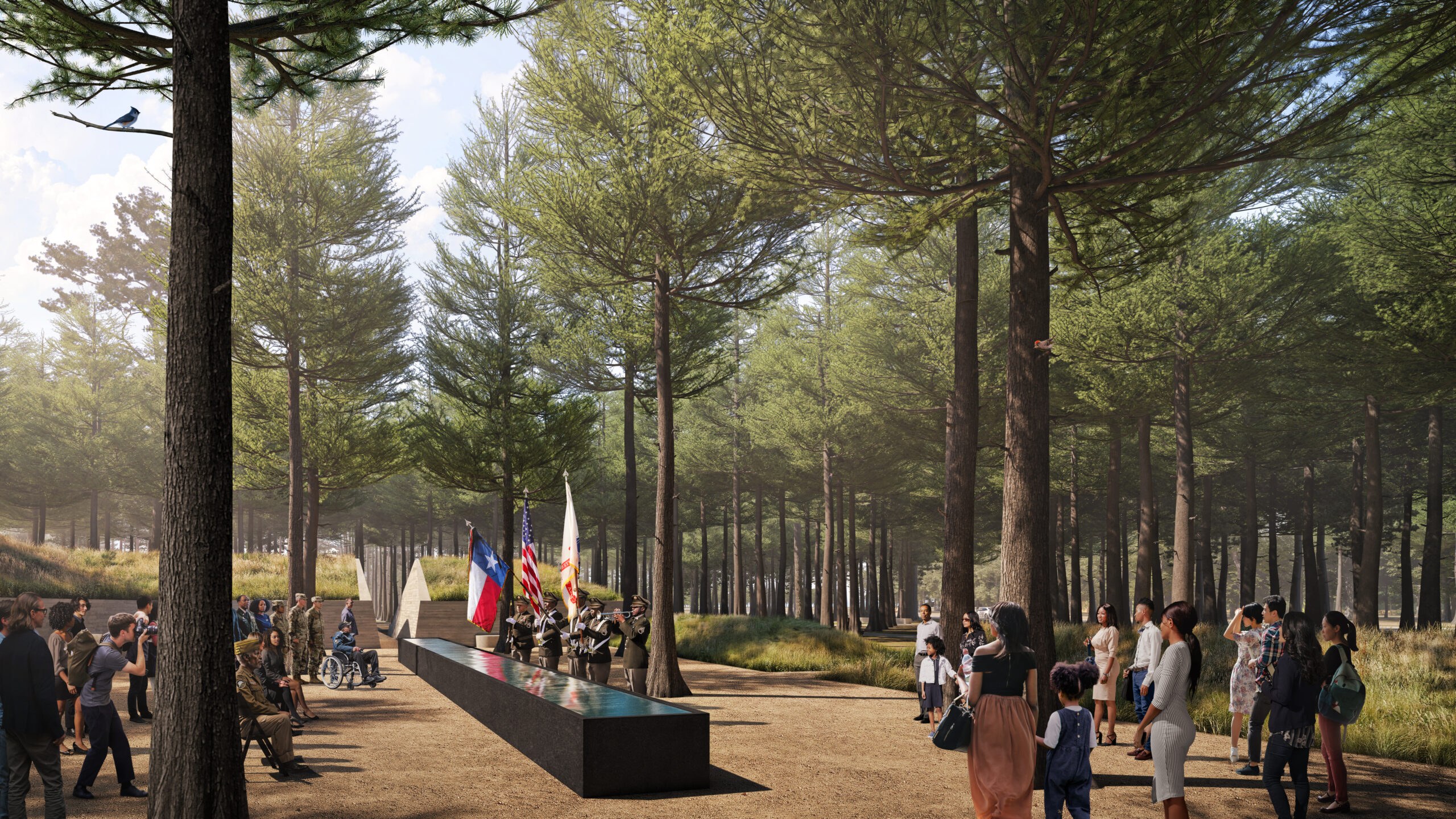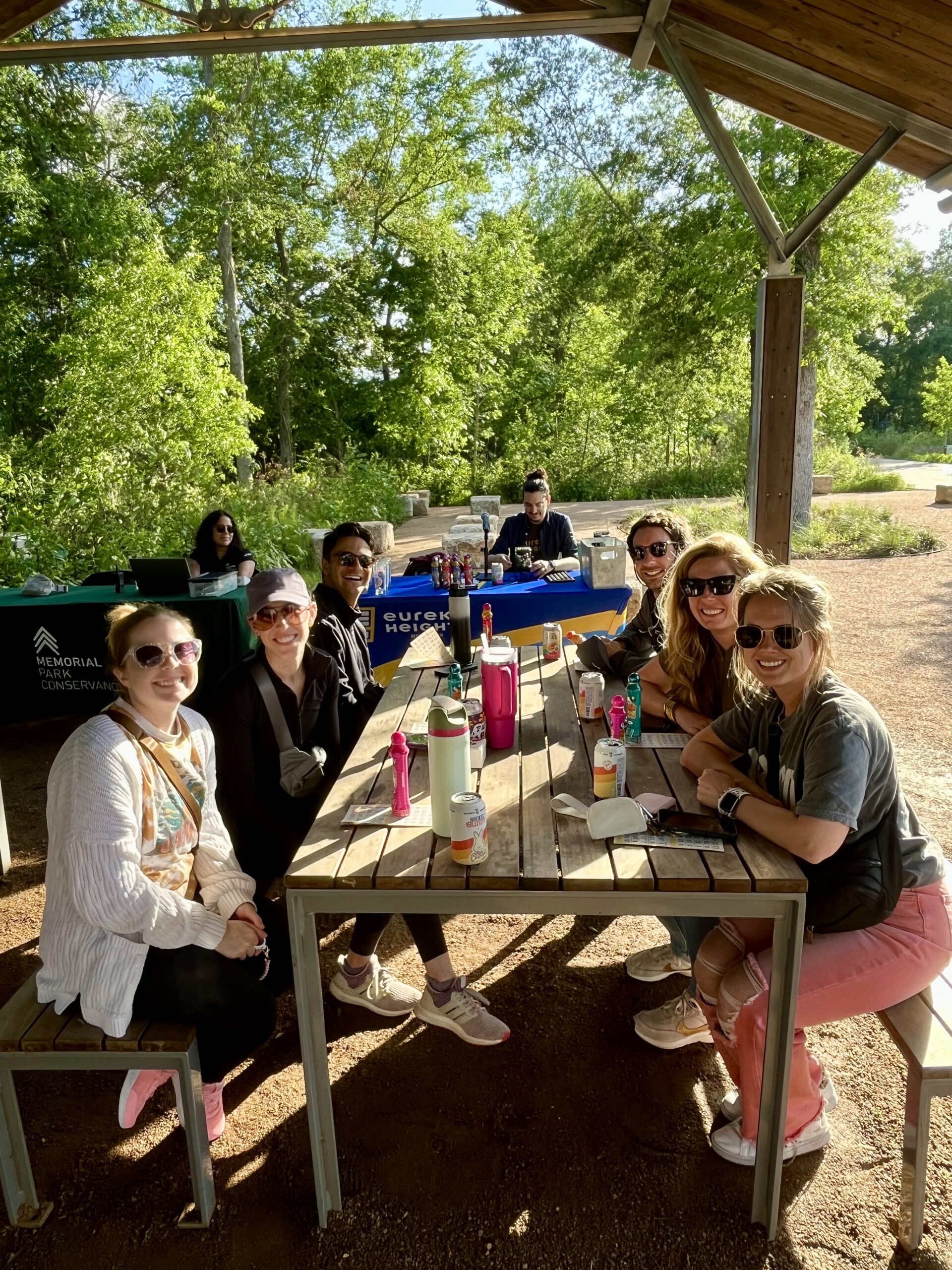MEMORIAL PARK CONSERVANCY UNVEILS PLANS FOR MEMORIAL GROVES

A NEW $42M PROJECT OF THE 2015 MASTER PLAN.
Kinder Foundation, John L. Nau III, and Brown Foundation Provide Lead Donor Gifts
Houston, TX – Memorial Park Conservancy unveiled plans today for a poetic re-imagining of 100 acres along West Memorial Loop Drive that will be known as Memorial Groves. Accelerated by the generosity of Kinder Foundation($10 million), John L. Nau, III ($7.5 million) and Brown Foundation ($7.5 million), this $42 million project is the latest of several transformative improvements envisioned by the Memorial Park Master Plan, central to the ongoing revitalization of Houston’s largest urban greenspace.
“We feel truly privileged to be at the forefront of this remarkable project,” said Chris Ballard, President and CEO for Memorial Park Conservancy. “Many of our daily park visitors may not be aware of Memorial Park’s rich history. We hope that’s exactly what Memorial Groves will accomplish: to tell the story of Memorial Park, how it came to be, and why it’s crucial to preserve and protect into its second century. The generosity of the Kinder Foundation, the Brown Foundation, and Mr. Nau provide foundational support for this project, and serve as a call to others to support the telling of this important part of Memorial Park’s and Houston’s history.”
Memorial Groves will honor the original vision of the park as a greenspace that pays tribute to Houston’s World War I (WWI) history, while also adding new recreational amenities and additional parking for everyday park users.
All of what is now Memorial Park was utilized from 1917 to 1919 by the United States Army as the heart of Camp Logan, a WWI cantonment, or temporary training facility. Memorial Groves is located within a narrow tract of the park that runs north to south, primarily between the Union Pacific rail line and West Memorial Loop Drive. This location holds the largest number of Camp Logan archeological finds within the park, enabling the Conservancy and its partners to preserve and interpret the last of 32 such sites across the United States where WWI soldiers trained. In addition, the project will provide opportunities to expand current recreational offerings with new elements including a children’s playground, adult workout areas, cycling, hiking, and walking trails, open lawn areas for play and picnicking, as well as a covered pavilion and new restrooms.
“Memorial Groves will be a very special place for Houstonians, offering the unique WWI history of the park combined with recreational amenities and educational opportunities,” said Nancy Kinder, president and CEO of Kinder Foundation. “We anticipate that Memorial Groves will become a destination on a local and national level because of its beauty and history.”
“Memorial Groves will highlight a piece of Houston’s WWI-era history that has been under-told and is at risk of being forgotten,” said Nau, businessman, community leader and philanthropist. Nau is known throughout the nation as a leading advocate for American history, historic preservation and conservation of American battlefields and National Parks. He is the premier collector of Civil War artifacts and documents and has served in leadership roles for many civic, community and philanthropic organizations throughout Texas and the United States. “I am proud to support Memorial Park Conservancy and their commitment to tell the story of the significance of the park’s name by paying tribute to Camp Logan. Memorial Groves will inform future generations about an important time in our community’s history while providing educational, recreational and park-based areas,” he said. “This unique space will weave together all of these elements in a living landscape to be experienced and enjoyed by Houstonians and visitors.”
About Memorial Groves
Designed by Nelson Byrd Woltz Landscape Architects, the focal point of Memorial Groves will be a living remembrance that changes colors with the seasons – a forest of more than 2,000 bald cypress that will be planted in a grid around mature existing trees. These cypress trees, covering twenty acres along West Memorial Loop Drive, will symbolize soldiers standing in formation and evoke the vast scale of Camp Logan and the overall war effort. A contemplative earthwork inspired by WWI trenches will be situated at the north end of the forest and framed on two sides by grassy, 12-foot-tall earthen mounds creating a serene space with a reflective water feature at its center.
Visitors will learn about the lives and daily routines of the camp’s soldiers as they view the unearthed foundations of several modest camp buildings that lie between two important native habitats: an existing prairie, which will be protected and preserved, and a twenty-acre expanse of savanna habitat that will be restored as part of the project.
Enhanced amenities set within the restored native landscape and newly planted cypress groves will include a new playground, trails for cyclists and walkers as well as lawns and other spaces for picnics and family play.
A new visitors’ center designed by Moody Nolan will anchor the north end of Memorial Groves and will include offices for Memorial Park Conservancy. A series of linear, open lawns will demarcate the former Camp Logan streets, while new parking spaces will be added at both ends of Memorial Groves.
Interpretive features, signage, and exhibits distributed throughout the Memorial Groves landscape and visitors’ center will engage both visitors and everyday park users with the history of Camp Logan and the stories of individual soldiers who trained there.
“The Memorial Groves project fulfills the vision of the park’s founders who a century ago preserved the 1,200 acres of Camp Logan as a living memorial to the 70,000 soldiers who trained there. This landscape-scale memorial utilizes thousands of newly planted trees and savanna restoration to evoke the immensity of transformation, sacrifice, and bravery, of the individuals who arrived here as civilians and Guardsmen,” said Thomas Woltz, Principal and Owner, Nelson Byrd Woltz Landscape Architects (NBW).
The NBW team led the design process and worked in close collaboration with Memorial Park Conservancy, its partners, and consultants specializing in archaeology, history, ecology, and accessibility, to ensure the new landscape serves all Houstonians. The team also engaged the public and other experts at important milestones during the development of the design.
Moving the Ten-Year Plan Forward
Conceived by NBW as an original element of the Memorial Park Master Plan, Memorial Groves is among a suite of projects that were accelerated through a Ten-Year Plan initiated in 2018.
The Memorial Park Master Plan was initiated to restore the park’s ecology and improve its amenities after severe drought decimated more than 60 percent of the tree canopy in 2011-12. Houston City Council approved the Master Plan, whose projects are driven by public-private partnerships, in 2015.
To accelerate the delivery of major Master Plan projects, the Ten-Year Plan was launched in 2018 with a $70 million catalyst gift from Kinder Foundation, which leveraged funding through the Uptown Development Authority, and by the generosity of other donors. Memorial Park Conservancy is delivering these projects through partnerships with the Houston Parks and Recreation Department, Uptown Houston, and Kinder Foundation.
Ten-Year Plan projects completed to date include the 100-acre Clay Family Eastern Glades (opened July 2020); the Sports Complex (opened October 2020); a one-mile segment of the Seymour Lieberman Trail through the trees and over ravines (opened October 2022); the 100-acre Kinder Land Bridge and Cyvia and Melvyn Wolff Prairie (opened February 2023); and the Running Complex (opened November 2023).
Remaining projects of the Ten-Year Plan include the Southern Arc Trail along the park’s southern edge and the Uptown Memorial Park Trail connecting the park to the broader community.
All of the projects promote connectivity and resiliency, restore damaged ecologies to provide higher function for the park and city, help manage storm water, provide new cultural and recreational amenities, and tell the historical narratives of the people and the land through landscape design.
Park History
Memorial Park was established in 1924, after Houstonians campaigned for a public space to remember the 70,000 young men who trained at the camp. Many sacrificed their lives during the war.
Ilonda B. Benda, a community activist of the era, was among those who led the charge to memorialize the soldiers. “Whatever may come or now be made of our Camp Logan, we never can escape the fact that once upon a time… the very heart of our nation beat within this sphere,” she wrote in an article that appeared in the Houston Chronicle in 1923.
Benefactors Will and Mike Hogg, with minority owner Henry Stude, bought two tracts of the decommissioned land and sold them to the City at cost to create the 1,500-acre park. Over time, however, as roads, a golf course and other recreational amenities were added to the landscape, the meaning behind Memorial Park’s name was largely lost.
Now, more than a century later, the future Memorial Groves will honor all who contributed to the war effort at Camp Logan, including those who trained there with the U.S. Army’s 370th Infantry Regiment and the Cavalry; the 24th Infantry Regiment, who oversaw the construction of the camp; and local organizations such as the YMCA that participated in camp life.
Construction Timeline
Preliminary site work and ecological restoration for Memorial Groves will begin in April 2025, when fencing will be erected around the project area.
The western portion of the Outer Loop Trail will be closed to users during this period, along with several parking spaces along West Memorial Loop Drive.
Construction is slated to begin in 2026, with a target completion date of 2027.
Memorial Groves Project Team:
Master Plan Design and Project Landscape Architect: Nelson Byrd Woltz Landscape Architects
Architect: Moody Nolan
Environmental Design: Blackland Collaborative
Archaeology: Gray & Pape, Inc.
General Contractor: Tellepsen
African American / Military Historian – Dr. Jeffrey Sammons
Interpretation / Exhibitry Design – Gallagher & Associates
Ten-Year Plan Project Partners:
Memorial Park Conservancy
Houston Parks & Recreation Department
Uptown Houston
Kinder Foundation



